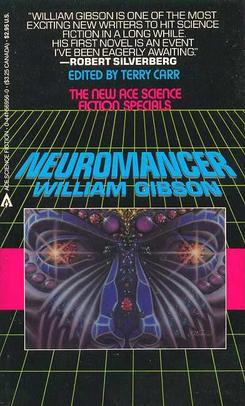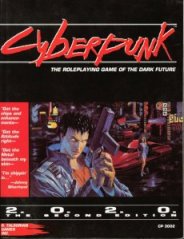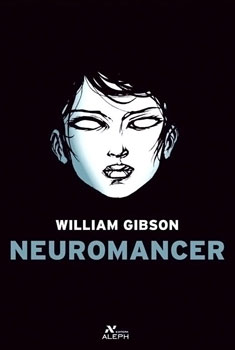
Cyberpunk is a subgenre of science fiction in a dystopian futuristic setting that tends to focus on a "combination of lowlife and high tech", featuring futuristic technological and scientific achievements, such as artificial intelligence and cybernetics, juxtaposed with societal collapse, dystopia or decay. Much of cyberpunk is rooted in the New Wave science fiction movement of the 1960s and 1970s, when writers like Philip K. Dick, Michael Moorcock, Roger Zelazny, John Brunner, J. G. Ballard, Philip José Farmer and Harlan Ellison examined the impact of drug culture, technology, and the sexual revolution while avoiding the utopian tendencies of earlier science fiction.

Neuromancer is a 1984 science fiction novel by American-Canadian writer William Gibson. Considered one of the earliest and best-known works in the cyberpunk genre, it is the only novel to win the Nebula Award, the Philip K. Dick Award, and the Hugo Award. It was Gibson's debut novel and the beginning of the Sprawl trilogy. Set in the future, the novel follows Henry Case, a washed-up hacker hired for one last job, which brings him in contact with a powerful artificial intelligence.

William Ford Gibson is an American-Canadian speculative fiction writer and essayist widely credited with pioneering the science fiction subgenre known as cyberpunk. Beginning his writing career in the late 1970s, his early works were noir, near-future stories that explored the effects of technology, cybernetics, and computer networks on humans—a "combination of lowlife and high tech"—and helped to create an iconography for the information age before the ubiquity of the Internet in the 1990s. Gibson coined the term "cyberspace" for "widespread, interconnected digital technology" in his short story "Burning Chrome" (1982), and later popularized the concept in his acclaimed debut novel Neuromancer (1984). These early works of Gibson's have been credited with "renovating" science fiction literature in the 1980s.

Cyberpunk is a tabletop role-playing game in the dystopian science fiction genre, written by Mike Pondsmith and first published by R. Talsorian Games in 1988. It is typically referred to by its second or fourth edition names, Cyberpunk 2020 and Cyberpunk Red, in order to distinguish it from the cyberpunk genre after which it is named.

John Shirley is an American writer, primarily of fantasy, science fiction, dark street fiction, westerns, and songwriting. He has also written one historical novel, a western about Wyatt Earp, Wyatt in Wichita, and one non-fiction book, Gurdjieff: An Introduction to His Life and Ideas. Shirley has written novels, short stories, TV scripts and screenplays—including The Crow—and has published over 84 books including 10 short-story collections. As a musician, Shirley has fronted his own bands and written lyrics for Blue Öyster Cult and others. His newest novels are Stormland and Axle Bust Creek.

Mona Lisa Overdrive is a science fiction novel by American-Canadian writer William Gibson, published in 1988. It is the final novel of the cyberpunk Sprawl trilogy, following Neuromancer and Count Zero, taking place eight years after the events of the latter. The novel was nominated for the Nebula Award for Best Novel, the Hugo Award for Best Novel, and the Locus Award for Best Science Fiction Novel in 1989.

Altered Carbon is a 2002 cyberpunk novel by the English writer Richard K. Morgan. Set in a future in which interstellar travel and relative immortality is facilitated by transferring consciousnesses between bodies ("sleeves"), it follows the attempt of Takeshi Kovacs, a former U.N. elite soldier turned private investigator, to investigate a rich man's death. It is followed by the sequels Broken Angels and Woken Furies.

Molly Millions is a recurring character in stories and novels written by William Gibson, particularly his Sprawl trilogy. She first appeared in "Johnny Mnemonic", to which she makes an oblique reference in Neuromancer. She later appeared in Mona Lisa Overdrive under the name "Sally Shears".

Eden: It's an Endless World! is a science fiction manga by Japanese artist Hiroki Endo, published monthly in the Japanese magazine Monthly Afternoon. It is published in the United States by Dark Horse Comics, in the United Kingdom by Titan Books, and in Germany by Egmont Manga & Anime. Eden is set in the near future, following a pandemic called closure virus which killed 15 percent of the world's population, crippled or disfigured many more, and upset the world's political balance greatly. Eden is to some extent based on Gnostic mythology, with some characters, such as Ennoia, being named after Gnostic entities, and other Gnostic influences being seen in the themes of the ongoing story.

Nоva is a science fiction novel by American writer Samuel R. Delany and published in 1968. Nominally space opera, it explores the politics and culture of a future where cyborg technology is universal, yet making major decisions can involve using tarot cards. It has strong mythological overtones, relating to both the Grail Quest and Jason's Argonautica for the golden fleece. Nova was nominated for the Hugo Award for Best Novel in 1969. In 1984, David Pringle listed it as one of the 100 best science-fiction novels written since 1949.
Brain implants, often referred to as neural implants, are technological devices that connect directly to a biological subject's brain – usually placed on the surface of the brain, or attached to the brain's cortex. A common purpose of modern brain implants and the focus of much current research is establishing a biomedical prosthesis circumventing areas in the brain that have become dysfunctional after a stroke or other head injuries. This includes sensory substitution, e.g., in vision. Other brain implants are used in animal experiments simply to record brain activity for scientific reasons. Some brain implants involve creating interfaces between neural systems and computer chips. This work is part of a wider research field called brain–computer interfaces.

The Ware Tetralogy is a series of four science fiction novels by author Rudy Rucker: Software (1982), Wetware (1988), Freeware (1997) and Realware (2000).

The Ticket That Exploded is a 1962 novel by American author William S. Burroughs, published by Olympia Press and later by Grove Press in 1967. Together with The Soft Machine and Nova Express it is part of a trilogy, referred to as The Nova Trilogy, created using the cut-up technique, although for this book Burroughs used a variant called 'the fold-in' method. The novel is an anarchic tale concerning mind control by psychic, electronic, sexual, pharmaceutical, subliminal, and other means. Passages from the other two books and even from this book show up in rearranged form and are often repeated. This work is significant for fans of Burroughs, in that it describes his idea of language as a virus and his philosophy of the cut-up technique. It also features the cut-up technique being used by characters within the story. The Ticket That Exploded lays the groundwork for Burroughs' ideas of social revolution through technology, which he would later detail in his book-length essay The Electronic Revolution.

Dystopia is a team-based, objective-driven, first-person shooter video game, developed as a total conversion modification on the Valve's proprietary Source engine. It is based on the cyberpunk literary and aesthetic genre; it is somewhat based on popular role-playing game Shadowrun, created by an amateur development team and released to the public for free. Its first playable build was released on September 9, 2005, after a year of planning and nine months of development. The first full version of Dystopia, Version 1, was released after 3 years of development on February 25, 2007.
Mind control has proven a popular subject in fiction, featuring in books and films such as The Manchurian Candidate and The IPCRESS File, both stories advancing the premise that controllers could hypnotize a person into murdering on command while retaining no memory of the killing. As a narrative device, mind control serves as a convenient means of introducing changes in the behavior of characters, and is used as a device for raising tension and audience uncertainty in the contexts of the Cold War and terrorism. Mind control has often been an important theme in science fiction and fantasy stories. Terry O'Brien comments: "Mind control is such a powerful image that if hypnotism did not exist, then something similar would have to have been invented: the plot device is too useful for any writer to ignore. The fear of mind control is equally as powerful an image."

The Host is a 2008 science fiction romance novel by Stephenie Meyer. The book is about Earth, in a post-apocalyptic time, being invaded by a parasitic alien race known as "Souls", and follows one Soul's predicament when the consciousness of her human host refuses to give up her body.

Shadowrun is a science fantasy tabletop role-playing game set in an alternate future in which cybernetics, magic and fantasy creatures co-exist. It combines genres of cyberpunk, urban fantasy and crime, with occasional elements of conspiracy, horror and detective fiction. From its inception in 1989, Shadowrun has remained among the most popular role-playing games. It has spawned a vast franchise that includes a series of novels, a collectible card game, two miniature-based tabletop wargames, and multiple video games.
This is the complete list of works by American science fiction author S. M. Stirling.
List of works by or about British science fiction author Peter F. Hamilton.

Hardwired: The Sourcebook is a supplement published by R. Talsorian Games in 1989 for the dystopian near-future science fiction role-playing game Cyberpunk.















